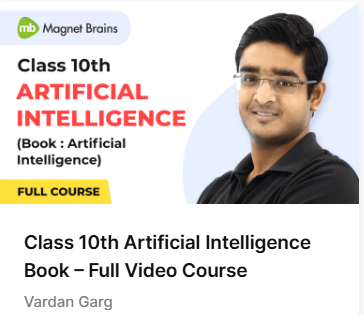What will i learn?
Curriculum for this course
205 Lessons
178:13:00 Hours
Theory : Unit 1 - Introduction to AI
10 Lessons
07:32:58 Hours
- 1.1 Intelligence and Its Traits 00:12:23
- 1.2 Decision Making 00:10:48
- 1.3 Defining AI (Various Definitions) 00:06:26
- 1.4 How do Machines Become Artificially Intelligent? 00:08:01
- 1.5 What Is AI / What Is Not AI? 00:17:49
- 1.6 AI vs Machine Learning vs Deep Learning (Differences) 00:21:03
- 1.7 Domains of AI: Data Science,NLP,CV 00:13:21
- 1.8 Ethics of Artificial Intelligence 00:37:05
- 1.9 Multiple Choice Questions 01:46:27
- 1.10 Introduction to AI - Complete Chapter in One Video 03:39:35
Theory : Unit 2 - AI Project Cycle
19 Lessons
17:40:34 Hours
- 2.1 Overview 00:38:16
- 2.2 Problem Scoping: Schema 00:23:02
- 2.3 Problem Scoping 00:23:02
- 2.4 Data Acquisition: What is Data? 00:41:55
- 2.5 Data Acquisition: Acquiring Data & System Maps 00:46:37
- 2.6 Data Exploration: What is EDA? & Various Types of Graphs 00:25:37
- 2.7 Data Exploration: Types of Graphs in Detail With Examples 00:35:18
- 2.8 Modelling: Learning Based & Rule Based Approach 00:16:24
- 2.9 Modelling: Rule based (Decision Tree) 00:29:00
- 2.10 Modelling: Learning Based (Supervised & Unsupervised) 00:17:33
- 2.11 Modelling: Learning-Based (Reinforcement Learning) 00:30:42
- 2.12 Modelling: Algorithms 00:41:09
- 2.13 Modelling: Introduction to Neural Networks 00:16:02
- 2.14 Modelling: Human Nervous System 00:14:36
- 2.15 Modelling: Artificial Neural Networks 00:31:29
- 2.16 Working of Artificial Neural Networks 00:18:09
- 2.17 Evaluation 00:11:51
- 2.18 Multiple Choice Questions 03:04:45
- 2.19 AI Project Cycle - Complete Chapter in One Video 06:55:07
Practical : Unit 3 - Recap: What is Programming?
32 Lessons
49:34:47 Hours
- 3.1 Advance Python 00:12:44
- 3.2 Advance Python - Recap: Need of Programming Language 00:17:36
- 3.3 Advance Python - Recap: Why Python? 00:17:59
- 3.4 Advance Python - Recap: Installing Python for Windows 00:21:40
- 3.5 Advance Python - Recap: IDE and Its Installation 00:39:54
- 3.6 Advance Python - Recap: Installing Python on Cell Phones 00:13:57
- 3.7 Advance Python - Recap: Pip, Libraries, Packages, Modules 00:35:58
- 3.8 Advance Python - Recap: Error Solution 00:20:45
- 3.9 Advance Python - Recap: Jupyter Notebook 00:32:56
- 3.10 Advance Python - Recap: Anaconda (Practical) 00:27:41
- 3.11 Recap: First Program & File Extensions 00:32:23
- 3.12 Recap: Python As a Calculator 00:18:52
- 3.13 Recap: Statements 00:34:24
- 3.14 Indentation & Comments 00:27:07
- 3.15 Keywords & Identifiers 00:40:28
- 3.16 Variables & Constants 00:32:01
- 3.17 Recap: Literals (Part 7) 01:04:21
- 3.18 Introduction to Data Types 01:08:50
- 3.19 Type Conversions & Type Castings 01:32:12
- 3.20 Operators 01:07:19
- 3.21 Operators, Precedence & Associativity 00:43:17
- 3.22 Taking Input From Users 01:02:50
- 3.23 Print Function 00:46:35
- 3.24 Output Formatting 01:46:20
- 3.25 Escape Sequences 00:57:30
- 3.26 Conditionals 01:55:04
- 3.27 Iterations & Looping 02:06:46
- 3.28 Importing Modules & Packages 01:04:03
- 3.29 Virtual Environment 01:00:58
- 3.30 Multiple Choice Questions 03:53:59
- 3.31 Advance Python - Full Chapter (Part 1) 11:09:29
- 3.32 Advance Python - Full Chapter (Part 2) 11:08:49
Theory : Unit 4 - Data Science
35 Lessons
32:02:13 Hours
- 4.1 Chapter Overview 00:15:29
- 4.2 Introduction 00:32:31
- 4.3 Applications of Data Science (Part 1) 00:44:57
- 4.4 Applications of Data Science (Part 2) 00:48:43
- 4.5 Revisiting AI Project Cycle 00:09:36
- 4.6 Revisiting AI Project Cycle (The Scenario) 00:12:24
- 4.7 Revisiting AI Project Cycle (Problem Scoping) 00:13:17
- 4.8 Revisiting AI Project Cycle (Data Acquisition) 00:24:05
- 4.9 Revisiting AI Project Cycle (Data Exploration) 00:17:39
- 4.10 Modelling - Revisiting AI Project Cycle 00:23:43
- 4.11 Revisiting AI Project Cycle (Evaluation) 00:17:39
- 4.12 Data Collection 00:24:29
- 4.13 Data Access 00:23:32
- 4.14 NumPy (Part 1) 00:33:19
- 4.15 NumPy (Part 2) 00:32:55
- 4.16 NumPy (Part 3) 00:24:15
- 4.17 NumPy (Part 4) 00:43:12
- 4.18 Pandas (Part 1) 00:09:46
- 4.19 Pandas (Part 2) 00:31:18
- 4.20 Pandas (Part 3) 00:48:03
- 4.21 Pandas (Part 4) 00:31:50
- 4.22 Pandas (Part 5) 00:32:06
- 4.23 Pandas (Part 6) 00:31:11
- 4.24 Basic Statistics With Python 00:28:32
- 4.25 Basic Statistics With Python (Practical) 00:27:37
- 4.26 Data Visualization 00:16:54
- 4.27 Data Visualization Using Matplotlib 00:08:17
- 4.28 Line Graph Using Matplotlib 00:57:33
- 4.29 Scatter Plot Using Matplotlib 00:38:35
- 4.30 Box Plot Using Matplotlib 00:39:51
- 4.31 Bar Chart 00:56:24
- 4.32 What Is Histogram? 00:52:34
- 4.33 Classification Model: K-Nearest Neighbour 00:32:21
- 4.34 Working of K-Nearest Neighbour (KNN) Algorithm 00:28:07
- 4.35 Data Science - Complete Chapter in One Video 15:09:29
Theory : Unit 5 - Computer Vision
74 Lessons
52:35:22 Hours
- 5.1 Overview 00:23:42
- 5.2 Introduction to Computer Vision 00:27:13
- 5.3 Computer Vision Vs Human Vision 00:23:33
- 5.4 Applications of Computer Vision (Part 1) 01:34:50
- 5.5 Applications of Computer Vision (Part 2) 01:17:49
- 5.6 Getting Started With Computer Vision 00:23:16
- 5.7 Image Processing 00:27:32
- 5.8 Computer Vision Tasks 00:26:08
- 5.9 Computer Vision Hierarchy 00:13:35
- 5.10 Basics of Images 00:26:03
- 5.11 Basics of Pixels 00:25:19
- 5.12 Pixel Value 00:45:21
- 5.13 Resolution 00:26:01
- 5.14 Types of Images 00:14:01
- 5.15 Binary Images 00:19:09
- 5.16 Grayscale Image 00:23:51
- 5.17 RGB Images 00:29:43
- 5.18 Colour Tool 00:29:46
- 5.19 How Do Computers See/Read Images? 00:17:28
- 5.20 Image Features 00:33:24
- 5.21 Introduction to OpenCV 00:22:18
- 5.22 Downloading & Installing OpenCV in Windows 00:35:48
- 5.23 OpenCV Reading an Image From a File 01:33:06
- 5.24 OpenCV Display an Image in an OpenCV Window 01:14:47
- 5.25 OpenCV Display an Image in Jupyter Notebook 00:41:10
- 5.26 OpenCV Creating a Window 00:57:16
- 5.27 OpenCV Displaying Multiple Images 00:53:02
- 5.28 OpenCV Access Image Properties 00:43:34
- 5.29 OpenCV Understanding Image Matrix 01:25:20
- 5.30 OpenCV Accessing & Modifying Pixel Values 01:10:42
- 5.31 OpenCV Splitting and Merging Channels 01:25:47
- 5.32 OpenCV Resizing Image 00:54:18
- 5.33 OpenCV Rotating Image 00:37:27
- 5.34 OpenCV Flipping Image 00:27:24
- 5.35 OpenCV Cropping Image (ROI) 00:49:27
- 5.36 OpenCV Making Borders for Images (Padding) 00:57:57
- 5.37 OpenCV Image Blending 00:57:02
- 5.38 OpenCV Bitwise Operations 01:10:40
- 5.39 OpenCV Changing Colourspaces 00:51:48
- 5.40 OpenCV Drawing Lines 01:13:22
- 5.41 OpenCV Drawing Arrowed Lines 00:50:01
- 5.42 OpenCV Drawing Rectangles 00:59:01
- 5.43 OpenCV Drawing Circles 00:52:12
- 5.44 OpenCV Drawing Ellipse 01:24:09
- 5.45 OpenCV Drawing Polygons 01:18:58
- 5.46 OpenCV Drawing a Text String 01:13:53
- 5.47 OpenCV Drawing Markers 00:40:23
- 5.48 OpenCV Saving Image 00:54:50
- 5.49 OpenCV Playing Video From a File 01:15:00
- 5.50 OpenCV Capture Video from Camera 01:02:51
- 5.51 OpenCV Editing Video 00:37:15
- 5.52 OpenCV Saving Video 01:08:32
- 5.53 OpenCV Saving Every Frame Of a Video 00:26:41
- 5.54 OpenCV Saving Videos Made Using Numpy and Random Images 00:30:09
- 5.55 OpenCV Access Phone Camera in PC 00:27:40
- 5.56 OpenCV Fetching Youtube Videos 00:36:45
- 5.57 OpenCV Screen Recorder 00:30:39
- 5.58 OpenCV Mouse Bindings 01:23:26
- 5.59 OpenCV Trackbar as Color Palette 00:34:36
- 5.60 Introduction to Convolution 00:34:19
- 5.61 Basic Understanding of Convolution 00:45:23
- 5.62 Convolution With Padding 00:51:02
- 5.63 Another Representation of Convolution With Padding 00:30:56
- 5.64 Strided (Convolution) 00:26:00
- 5.65 Kernel 00:29:08
- 5.66 Recap of Neural Network 00:13:04
- 5.67 Introduction to CNNs 00:35:03
- 5.68 Convolutional Layer 00:11:25
- 5.69 ReLU Layer 00:19:36
- 5.70 Pooling Layer 00:21:00
- 5.71 Fully Connected Layer 00:16:49
- 5.72 Advantages of CNNs 00:28:41
- 5.73 Future of CNNs 00:08:35
- 5.74 Testing of CNNs 00:07:21
Theory : Unit 6 - Natural Language Processing
24 Lessons
12:31:51 Hours
- 6.1 Overview 00:14:22
- 6.2 Introduction 00:26:06
- 6.3 Applications of Natural Language Processing (Part 1) 00:19:08
- 6.4 Applications of Natural Language Processing (Part 2) 00:24:26
- 6.5 Categories of Natural Language Processing 00:18:08
- 6.6 Levels of Natural Language Processing 00:27:05
- 6.7 Revisiting the AI Project Cycle - The Scenario (NLP) 00:12:15
- 6.8 Revisiting the AI Project Cycle -Problem Scoping (NLP) 00:13:16
- 6.9 Revisiting the AI Project Cycle -Data Acquisition & Exploration, Modelling 00:12:14
- 6.10 Revisiting the AI Project Cycle - Evaluation (NLP) 00:21:06
- 6.11 Introduction to Chatbot 00:27:04
- 6.12 Types of Chatbot 00:25:51
- 6.13 Language Differences 00:15:15
- 6.14 Language Differences - Arrangement of Words & Meaning 00:19:45
- 6.15 Language Differences - Multiple Meanings of a Word 00:10:43
- 6.16 Language Differences - Perfect Syntax, No Meaning 00:10:00
- 6.17 Text Normalization - Natural Language Processing 00:11:51
- 6.18 Text Normalization - Sentence Segmentation 00:11:32
- 6.19 Text Normalization - Word Tokenization 00:10:06
- 6.20 Text Normalization - Removing Stop Words, Special Characters & Numbers 00:13:22
- 6.21 Text Normalization - Lemmatization & Stemming 00:14:16
- 6.22 Text Normalization - Converting Text to a Common Case 00:08:11
- 6.23 Bag of Words - Natural Language Processing 00:26:50
- 6.24 Natural Language Processing - Complete Chapter in One video 05:58:59
Theory : Unit 7 - Evaluation
11 Lessons
06:15:15 Hours
- 7.10 Practice Ques on Accuracy, Precision, Recall & F1 Score 00:35:32
- 7.11 Evaluation - Complete Chapter in One Video 02:52:36
- 7.1 Overview 00:06:42
- 7.2 Introduction to Evaluation 00:23:24
- 7.3 Model Evaluation Terminologies - TP, TN, FP, FN 00:16:44
- 7.4 Model Evaluation Terminologies - Confusion Matrix 00:09:49
- 7.5 Evaluation Methods - Accuracy 00:25:27
- 7.6 Precision - Evaluation Methods 00:27:53
- 7.7 Recall - Evaluation Methods 00:14:16
- 7.8 Which Matric is Important? 00:20:49
- 7.9 F1 Score 00:22:03
Requirements
- Laptop
+ View more
Description
+ View more
Other related courses
Updated Tue, 27-May-2025
0
Free
Updated Tue, 27-May-2025
0
Free
About the instructor

- 0 Reviews
- 15 Students
- 16 Courses
Student feedback
Reviews

Write a public review